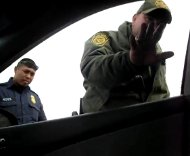4/5/2012
Federal Court Upholds Border Roadblock 25 Miles From BorderFederal court sees no problem with suspicionless search at checkpoint that focuses on drug arrests.

The US Supreme Court has upheld the use of suspicionless "border" roadblocks more located more than twenty-five miles from the actual border. In practice, these purported immigration checkpoints are heavily used to search motorists traveling between California and Arizona without probable cause. On Friday, the US District Court for the District of Arizona ruled that this conduct was permissible.
On January 19, 2011, Omar Ruiz-Perez, a commercial truck driver, was hauling produce from a warehouse in Rio Rico, Arizona to Los Angeles, California for the MRM Xpress trucking company. At around 8:30pm, he hit the roadblock on Interstate 19 located twenty-five miles from the actual border with Mexico.
Border Patrol Agent Christopher Thornton stopped him, and Ruiz-Perez explained that he was a US citizen and provided copies of his bill of lading, as requested. Thornton claimed the truck's US DOT number was "suspiciously high" and the truck's paint was not pristine. He asked if he could look in the back of the truck, and Ruiz-Perez said he did not care. Agents x-rayed the truck and found a hidden compartment containing drugs.
The Supreme Court in 1979 authorized supicionless roadblocks for immigration purposes on the US-Mexico border in the case US v. Martinez-Fuerte. In the 2000 case Indianapolis v. Edmond, the high court clarified that roadblocks could not be used if their primary purpose was detecting general crime and drug use. Ruiz-Perez's lawyer argued that the roadblock quickly became just that, a fishing expedition to detect general crime.
"There is no evidence that Agent Thornton doubted Mr. Ruiz-Perez's U.S. citizenship," defense attorney Leslie A. Bowman argued. "The inquiry should have ended there. Questioning after the agent accepted Mr. Ruiz-Perez's legal status prolonged his detention beyond the time necessary to interview him for immigration purposes."
Over 400 drug arrests each year are made at the I-19 roadblock, enough for the government to argue it had a "dual purpose" of immigration and crime control. US District Judge Jennifer G. Zipps asserted there was no reason to question whether the roadblock had a primary purpose other than immigration, and that the stop, therefore, was constitutional.
"The subjective intrusion of the I-19 checkpoint as measured by the fear and surprise engendered in law-abiding motorists by the nature of the stop is minimal," Zipps ruled. "The Supreme Court has found that the subjective intrusion from a checkpoint stop is significantly less than other types of seizures, such as random stops."
Zipps went on to justify Agent Thornton's decision to send the truck to secondary inspection by finding this did not deviate from standard inspection practice.
"At this point, agents could have objectively believed that defendant's truck, based on its size, contained evidence of alien smuggling such that defendant was committing an immigration violation," Zipps ruled.
Agent Thornton testified that he received a tip from another law enforcement agency that MRM Xpress might be involved in drug smuggling, but his sources of suspicion were the faded decals and markings on the truck.
"It is clear that, but for these markings, which were associated with drug trafficking, defendant would have been allowed to pass through the checkpoint," US Magistrate Judge D. Thomas Ferraro wrote in the findings on the case adopted by Zipps.
Zipps concluded that no articulable suspicion was needed for the x-ray since the driver consented to a search. Ruiz-Perez's trial will begin April 19.
A copy of the ruling on the motion to suppress is available in a 65k PDF file at the source link below.


